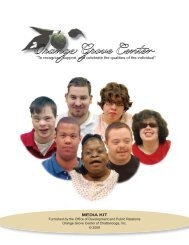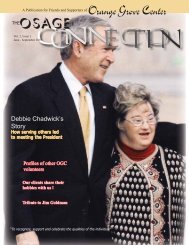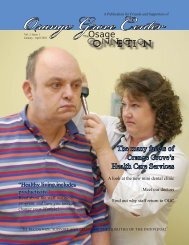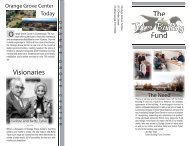osage connection winter spring 2009.indd - Orange Grove Center
osage connection winter spring 2009.indd - Orange Grove Center
osage connection winter spring 2009.indd - Orange Grove Center
You also want an ePaper? Increase the reach of your titles
YUMPU automatically turns print PDFs into web optimized ePapers that Google loves.
Morton J. Kent Habilitation <strong>Center</strong> still a leader after 15 years<br />
In the early 1990’s, the Board of Directors at <strong>Orange</strong> <strong>Grove</strong> <strong>Center</strong> had<br />
an “awakening.”<br />
While the center was amassing a fi fty-year history of creating respected<br />
programs for individuals with intellectual and developmental disabilities,<br />
they realized that the increasing degree of complex disabilities demanded<br />
a new avenue of innovation. Thus, the idea for a dedicated center with the<br />
responsibility for identifying emerging and evolving challenges that<br />
would impact on clients with special needs began to catch both the<br />
collective imagination and zeal of the board. The Habilitation <strong>Center</strong><br />
would serve as the seat of innovation that would address the needs of an<br />
aging and increasingly fragile and vulnerable population.<br />
Several factors contributed to the Board’s vision. They saw the level of<br />
disabling conditions increasing. Technological advances in neonatal<br />
intensive care saw the survival of high-risk newborns that would have<br />
never lived even ten years before. These survivors had multiple and<br />
combined challenges in cognition, behavior, learning, sensory, motor,<br />
and medical areas. In addition, they foresaw the increasing longevity of<br />
Page4<br />
Dr. Rick Rader, Director of the Morton J. Kent Habilitation <strong>Center</strong>,<br />
and Ruth Toon, Director of Residential Habilitation, will be<br />
featured in an upcoming documentary called, “Living with Autism.”<br />
The video is produced by MassMutual to compliment the<br />
national survey conducted by Easter Seals.<br />
individuals who were previously considered “lucky” to live into their twenties and thirties. These challenges required a new breed of<br />
direct support professionals; highly trained and motivated with goals far beyond the traditional exhibition of “compassionate care.”<br />
Finally, the board echoed the growing societal movement to increase the level of “expectations” of what individuals with developmental<br />
disabilities could and needed to achieve. <strong>Orange</strong> <strong>Grove</strong> was given the “green light” to move forward with plans to establish a center that<br />
would refl ect the dictates of Lawrence Miller, “The achievement of excellence can only occur if the organization promotes a culture of<br />
creative dissatisfaction.”<br />
Thus, what was to become the Morton J. Kent Habilitation <strong>Center</strong> began to break ground in 1993. Mr. Kent, a veteran board member, had<br />
been given the reins to spearhead the creation of the center, outline its mission and formulate the benchmarks of its success.<br />
A national search for the <strong>Center</strong>’s fi rst director had some challenges of its own. For one thing, there wasn’t a “pool” of professionals<br />
who were currently engaged in “developmental disabilities medical futurism,” the term that was coined to identify and funnel potential<br />
candidates that might be able to “pull this off.” While there were certainly pockets of researchers involved in developmental disabilities,<br />
there was no existing similar setting that could describe what was envisioned at <strong>Orange</strong> <strong>Grove</strong>. Most of the research activities involved<br />
single agendas related to cause, prevention, special education, bio and adaptive engineering, employment, habitation, healthcare, and<br />
technology assistance. There was no single position that supported a researcher without borders, boundaries or beliefs.<br />
Thus the fi rst innovation didn’t come “out” of the Habilitation <strong>Center</strong>; it went “into” it. The idea and notion that a center could maintain<br />
multiple inter-connected research portfolios was an innovation itself. Before someone was even given the keys to the front door, the<br />
center had a radical platform; that their coordinated efforts could drive and deliver programs in areas that were seemingly unrelated to<br />
mainstream disability research.<br />
The selection of Dr. Rick Rader as the <strong>Center</strong>’s fi rst Director evoked the belief that the most successful people are those who are good<br />
at Plan B. This best described Dr. Rader who never even had a Plan A. Like most physicians, he had no formal training, experience or<br />
expertise in the fi eld of intellectual and developmental disabilities. What he did have was cross-training in both medicine and medical<br />
anthropology, and a key appreciation for the biocultural determinants of health and disease. Relying mostly on his training in anthropology,<br />
he approached the opportunity with a cultural model. People with intellectual disabilities were a culture unto themselves; albeit part<br />
of a greater cultural body. They and the community that supports them have their own beliefs, mythology, values, tools, language, social<br />
structure, and history. His belief that you needed to understand, incorporate and employ these components laid the foundation for his appointment<br />
as the Director of the Morton J. Kent Habilitation <strong>Center</strong> in 1994. It was at best a mutual leap of faith for the two unknowns;<br />
a neophyte in the fi eld coupled with an idea without precedence and devoid of a clear blueprint. While far more developed than a sketch<br />
on the back of a napkin, the Morton J. Kent Habilitation <strong>Center</strong> had no track record, no modes and no examples.<br />
In the ensuing fi fteen years, the Habilitation <strong>Center</strong> has had its footprint in virtually every aspect of the fi eld of intellectual and developmental<br />
disabilities. Signifi cant contributions have been made via the expansion of universal newborn screening, positioning OGC as the<br />
fi rst agency in the U. S. to adopt a code of ethics, medical school curriculum development, adoption of using parents in medical education,<br />
solid university teaching and research affi liations, invitations to participate in top level national disability task forces, including the<br />
President’s Committee for People with Intellectual Disabilities, the Dept. of Defense and the Surgeon General’s offi ce, as faculty in the<br />
fi rst national interactive webinars in developmental disabilities, in creation of the fi rst research organization in the fi eld of sensory processing,<br />
creation of comprehensive end of life programs, affi liation with Exceptional Parent Magazine, the professionalization of direct






